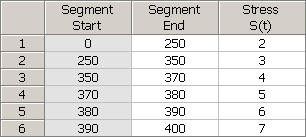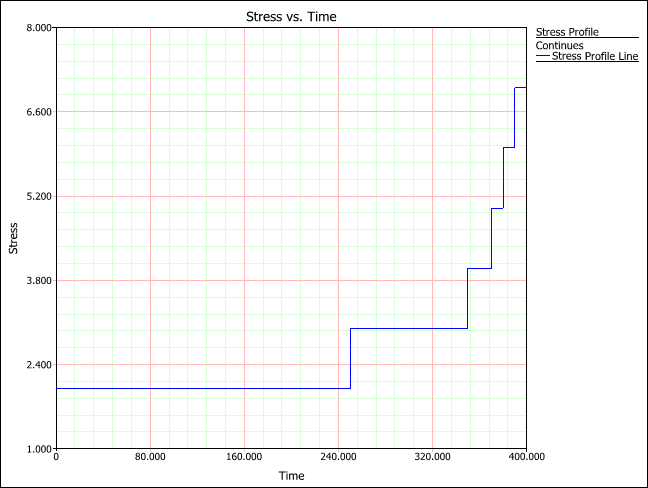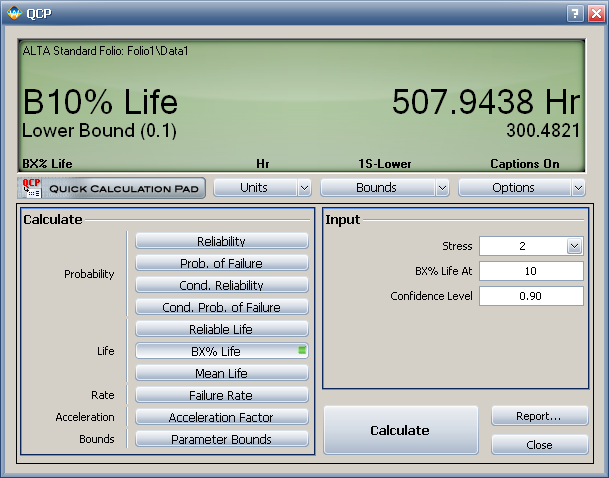![]()
![]()
| Related Topics: | ||

A reliability engineer is asked to determine, with a confidence level of 90%, whether an electronic component has a B10 life of at least 350 hours under ordinary conditions.
To simplify the analysis, the engineer will assume that the ordinary stress conditions for the component consist of a constant stress level of 2 V. However, because the ordinary stress conditions are known to involve escalating stress values, the component will be subjected to a time-varying voltage stress during testing. The following table describes the stress values that will be applied during the test.
Starting Time (Hr) |
Ending Time (Hr) |
Stress Level (V) |
0 |
250 |
2 |
250 |
350 |
3 |
350 |
370 |
4 |
370 |
380 |
5 |
380 |
390 |
6 |
390 |
400 |
7 |
All eleven units were tested to failure using the same stress profile. The following failure times were observed in the test.
Failure Time (Hr) |
Stress Level |
280 |
Time-varying |
310 |
Time-varying |
330 |
Time-varying |
352 |
Time-varying |
360 |
Time-varying |
366 |
Time-varying |
371 |
Time-varying |
374 |
Time-varying |
378 |
Time-varying |
381 |
Time-varying |
385 |
Time-varying |
Add a new ALTA standard folio by choosing Insert > Folios > ALTA Standard Folio. Since all the data are exact failure times, clear all of the check boxes in the Options for the Times-to-Failure Data Type area. Then, select Hour (Hr) from the Units drop-down list and click Next.
On the second page of the setup window, select Voltage as the stress types. Set the use stress level to 2 with V as the unit.
Click OK to close the setup window and view your new standard folio. Next, create a stress profile for voltage by choosing Insert > Tools > ALTA Stress Profile.
A new stress profile icon will appear in the current project explorer. Rename the new stress profile to “Voltage Step” by right-clicking the new stress profile icon and choosing Rename Item from the shortcut menu. Enter segment end times and stress values into the data sheet, as shown next.

Select Continue from last stress on the control panel. Click the Validate Stress Profile icon to save and validate the information in your new profile. Finally, click the Plot icon to view a stress vs. time plot for your profile. It should appear as shown next.

After creating the stress profile, return to your ALTA standard folio. Select CD-Weibull (i.e., the cumulative damage life-stress relationship combined with the Weibull life distribution) from the Model drop-down list. Click Stress Transformation and apply the Logarithmic transformation to the stress. Then, in the data sheet of the folio, enter the failure times. To assign the stress profile to a failure time, click the corresponding cell in the Voltage column of the data sheet. Click the arrow in the cell and choose Voltage Step from the drop-down list. After you have filled out the data sheet, it should appear as shown next.

Click the Calculate icon. The parameters of the model will be automatically computed and displayed in the Analysis Summary area.
To estimate the B10 life of the device, choose ALTA > Analysis > Quick Calculation Pad or click the icon on the control panel.
![]()
In the QCP, choose to calculate the BX% Life with Lower One-Sided confidence bounds. Select Hour for the time units and then make the following inputs:
Stress = 2
BX% Life At = 10
Confidence Level = 0.9
Click Calculate to display the results, as shown next.

The results show that the component's estimated B10 life is 507.9438 hours. The lower one-sided 90% confidence bound is shown to be 300.4821 hours. Thus, the test's results do not show with 90% confidence that the component's B10 life is at least 350 hours.
© 1992-2015. ReliaSoft Corporation. ALL RIGHTS RESERVED.